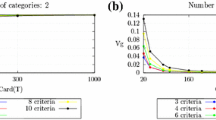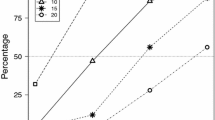Abstract
In this article we show that quantitative methods for multi-criteria evaluation have three serious shortcomings. First, the addition of an alternative which has bad criterion scores may distort the comparison between other alternatives. Second, the addition of a criterion which does not differentiate between alternatives may distort the comparison between alternatives. Third, when a ranking of alternatives is derived from a multi-criteria evaluation, it suggests complete transitivity. It is shown that intransitivity may occur.
Therefore a stepwise procedure is recommended. It involves the removal of all criteria which do not or hardly differentiate between the alternatives and a pairwise evaluation of alternatives.
Similar content being viewed by others
References
Benayoun, R., Roy, B. and Sussman, N. (1966). Manual de reference du programme electre. Note de Synthese et Formation. No. 25. Paris: SEMA.
Bernard, G. and Besson, M. L. (1971). Douze méthodes d'analyse multi critère. Revue Francaise d'Informatique et de Recherche Operationelle 5: 19–66.
Coombs, C. H. (1983). Psychology and Mathematics. Michigan: Michigan University Press.
Holmes, J. C. (1972). An ordinal method of evaluation. Urban Studies 9: 179–191.
Jacquet-Lagrèze (1969). L'aggregation des opinions individuelles. Informatique en Science Humaines. No. 4. pp. 8–24.
Keeney, R. L. and Raiffa, H. (1976). Decisions with Multiple Objectives: Preferences and Value Trade Offs. New York: Wiley.
Luce, R. D. et al. (1959). Individual Choice Behaviour. A Theoretical Analysis. New York: Wiley.
Massam, B. H. (1988). Multiple Criteria Decision Making. Oxford: Pergamon.
Paelinck, J. H. P. (1976). Qualitative Multiple Criteria Analysis. Papers for the Regional Science Association. New York: Seminar Press.
RARO/VWA (1986). Vestigingsplaatsen voor Kerncentrales. Tweede kamer, 18830, No. 43–44.
Roy, B. (1971). Problems and methods with multiple objective functions. Mathematical Programing 1: 239–266.
Schlager, K. (1968). The rank based expected value method of plan evaluation. Highway Research Record 238: 153–158.
Voogd, H. (1981). Multi Criteria Analysis with Mixed Qualitative-Quantitative Data. Delft University Press Planological Memorandum, pp. 81–86.
Voogd, H. (1983). Multi Criteria Evaluation for Urban and Regional Planning. London: Pion Ltd.
Yellot, J. I.Jr. (1977). The relationship between Luce's choice axiom, Thurstone's theory of comparative judgement and the double exponential distribution. Journal of Mathematical Psychology 15: 109–144.
Yoon-Ro, Lee and Stam, A. (1985). Multiple Criteria Decision Making. New York: Plenum Press.
Author information
Authors and Affiliations
Rights and permissions
About this article
Cite this article
De Vries, M.S. Stepwise multi-criteria evaluation. Qual Quant 26, 61–76 (1992). https://doi.org/10.1007/BF00177998
Issue Date:
DOI: https://doi.org/10.1007/BF00177998




